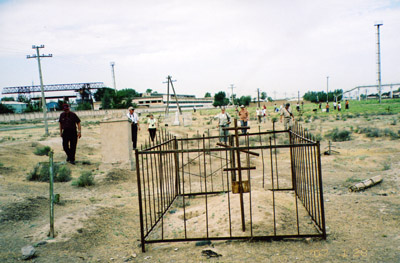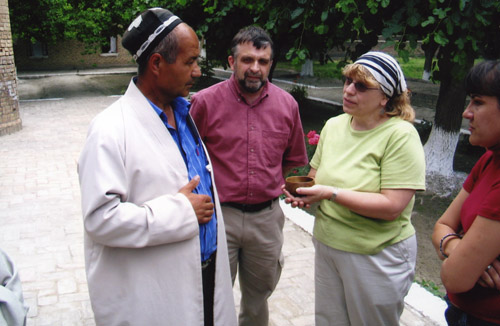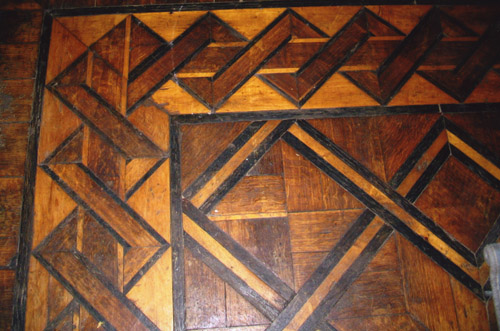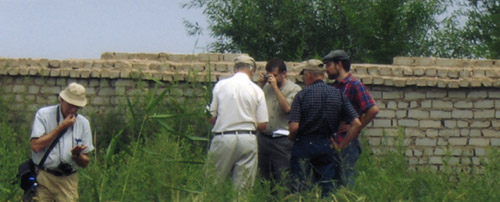
Christian graveyard at Serabulak(photo by Jim Juhnke)
 Fall 2007
vol. 62 no. 2
Back to Table of Contents
Fall 2007
vol. 62 no. 2
Back to Table of Contents
Jesse Nathan graduated from Bethel College in 2005. He is currently helping to produce a documentary about the Great Trek of 1880-1884 and the tour of 2007.
Late morning, June 3, 2007. Already the air hangs thick with a dusty, humid heat. We're wandering through tumbled-down remains of a sandy graveyard plot located between two sets of train tracks; twenty-five Americans, looking for traces of the past. We're wiping off the mostly illegible faces of tombstones. We're crouching down, reflecting silently or musing aloud about the erosions of weather and time. Around us, Uzbek locals cluster in groups, pausing from their morning tasks to witness our strange pilgrimage. They have reason to be intrigued: Americans, which typically means tourists, don't often come to this part of the country. It's not on any of the flashy souvenir maps, nor is it listed in the guidebooks—the nearby village of Serabulak, for instance, has only a few paved roads and its main attraction is the bustling, aroma-filled central market through which our massive bus has brought us en route to this spot.

Christian graveyard at Serabulak(photo by Jim Juhnke)
All of which begs the question: what are we, a potpourri of Mennonites whose eldest member is 81 years old and whose numbers include folks from Oregon, Colorado, Nebraska, Kansas, and Virginia, doing here?
We are ten days into a fifteen day pilgrimage "following the steps of the Great Trek," that has whisked us from our comparatively pedestrian lives to the barren flats of Uzbekistan. And now we're sweaty with pursuit. We are chasing and re-tracing a story, searching for clues to the presence of a group of Mennonites who, in the 1880s, passed through this village on their way to Shar-i-Sabz ("Valley of the Carrots"), the site, they urgently believed, where Jesus Christ would descend from heaven to inaugurate his kingdom.
Though Jesus Christ did not descend bodily to meet the Mennonites in Uzbekistan, the Great Trek of 1880 remains a relevant and vibrant story. In many ways, the story is still unfolding and it bubbles with questions for modern-day Christians everywhere: questions of inter-faith exchange, of the validity of hope and millennialism, of commitment to nonviolence, and of the communal healing of historical pain.
* * *
Our group of wayward Mennonites is picking through an Uzbek graveyard. The tour group includes historians, professors of religion, a film crew, and, forming the majority of our number, descendants of those who traveled to Central Asia under the leadership of Claas Epp, Jr. and Abraham Peters over a hundred years ago. Guided by local word-of-mouth, we've bumped and bounced our way to this train-track cemetery.
What we know from diaries and letters is that one wagon train of our Mennonite forebears found it necessary to camp for nine months in and around this village, Serabulak, in 1881-82. Nine months: long enough to plant and harvest a wheat crop, and to construct a mill on a nearby stream. Long enough, too, to have weddings, funerals, and sense of community with the locals. Our search in the graveyard yields little—the tombstones bear some German-sounding names, but the dates don't match the years the Mennonites were here. Our next search is for a nearby mosque where our Mennonites worshiped and camped at those nine months.
Fifteen minutes and a maze of dirt roads later, we are pulling up outside the Kyk-Ota ("Blue Grandfather") Mosque. It is the size of a country church; brown, worn and weathered, with a sanctuary not much bigger than a living room. Behind it, amidst high grass, is another cemetery. On one side, a reflecting pool. Though we can hardly believe we have found the mosque from 1880-1881, we have an old photograph, reprinted in Fred Belk's book, The Great Trek (1976) confirming for us that this is the place. Here are a telltale pillar in the front, distinct arabesque patterns over the archway, and doors that match the photograph. The day is quiet and sunny and we're dumbfounded. So, apparently, are the Imam and his assistant who step out to greet us.
For half an hour we walk—in a daze—around the building. We snap pictures and we take off our shoes to pray inside the mosque. Some of the descendants show family photographs and use hand signals (only one of our number speaks any Uzbek) to explain our connection with this Mosque to the Imam. Here at this mosque, during a toilsome part of the journey, the Mennonites found rest and friendship. And in this mosque these Christians conducted baptisms and held services—Mennonites worshiping on Sundays, Muslims on Fridays and Saturdays. One of our members, now in his late 70s, had a great aunt who, as a young woman, was married in this mosque in a double wedding over a century ago. Another among us is the great-great granddaughter of Claas Epp II. She's come from Oregon and she's bearing a hand-carved myrtlewood bowl.

Charlene Epp presents gift to imam at Kyk-Ota mosque (photo by Jim Juhnke)
"I want to offer you this gift," Charlene Epp tells the Imam through a translator.
We've gathered in a circle round the Imam and his assistant, watching, reveling. Charlene, head shawled, holds out the bowl cupped in her hands.
"We've come to thank you for befriending our ancestors." The Imam is nodding and smiling. His white robes quiver in the breeze. "To thank you for taking in our people many years ago," says Charlene.
The Imam is gracious and exuberant, clasping his hands together in the universal sign for prayer. He tells us he's impressed we've traveled this far to re-connect with our community.
"Blessings on you and your families," he offers. "Blessings, blessings."
Like wanderers in a dream, we make our way back to the bus. The sun is hot and its heat ripples off the road; the scene is surreal. Astounding as our experience is, however, it fits with what we've been discovering over the past week, everywhere we've gone, re-tracing the path the Mennonites took. That is, these peaceful Christians were shepherded by Muslims everywhere they went in a land that was (and still is) largely Islamic—and our Mennonites, for their part, left behind a wake of goodwill and friendship returned so strong it's lasted well over a century. So strong that we too bask in its fruits.
One must remember as well that this history transpired in the 1800s. The word inter-faith did not exist. Most of the exchanges between these two religions were (and arguably still are) violent, like the Crusades, involving forced conversions, or the conquests of the Russian Empire (a Christian body) in the region. But the local memory of these Mennonites is strong, and strongly positive, especially in the area of Khiva. Certainly, our Mennonite spiritual ancestors must have seemed a strange people: clad in simple clothes, stoic, stern-faced, speaking an obscure form of German, determined but quiet. Strange, yes—but to Uzbeks everywhere, these Mennonites were viewed as proud, hard-working, private people. And with good reason: from Russia, our Mennonites brought tomatoes, potatoes, dairy cattle, butter, and cheese. They never foisted their deeply-held Christian beliefs on their Muslim neighbors. But they demonstrated, in their mastery of farming and woodworking and by the strength of their tight-knit communities, the kind of ethic they believed in. They proved to be among Christendom's finest ambassadors.
Such an exchange, of course, raises surprising questions for modern Christians everywhere: one hundred years later, what kind of ambassadors are Christians sending forth, especially into the Muslim world? Do our communities have the kind of moral discipline and humility these two groups displayed in their interactions with one another? For long before interfaith exchange came into vogue, these Mennonites and Muslims were, without having to consciously decide anything, co-existing in peace. Could we now, either as strangers or hosts, behave like that? For Muslims and Christians to make peace in this way—to take each other in, to give of one another—seems, in our current, polarized world, somewhat radical. As we re-traced their steps, we tried to continue the legacy they left behind, replicating in a small way, via our exchange with the Imam at the Blue Grandfather Mosque, that peaceful grace these two very different peoples demonstrated a century ago.
A story buried and shamed for so long had, finally, begun to turn full circle.
* * *
Two days after our meeting with the Imam, we are back on the bus, this time departing from Khiva, an ancient outpost on the Silk Road between China and Europe. When, in 1884, the Mennonites arrived, bedraggled, at the Khan's palace in Khiva, their numbers had dwindled: those who persisted had survived theological and communal divisions, the Emir of Bukhara's refusal of entry into his protectorate, a rebuffing by the Russian authorities, and bands of burglarizing marauders at a previous temporary settlement called Lausan. They were weary and many had all but lost hope.
And then the Khan of Khiva offered the Mennonites a lush, quiet plot of land. Relieved, the journeyers began to construct a village compound. Their white-walled church building inspired the locals to affectionately dub the community Ak Metchet: White Mosque. The name stuck, and the Mennonites embraced it—a striking fact considering that everywhere they'd gone before they'd insisted on Christian or at least German names for their communities—names like Ebenezer or Gnadenfeld. The Bride Community had found a permanent home. Here Epp would twice predict Jesus' return. As his followers grew distrustful and disillusioned, he would recede into the shadows of his own community. On January 19, 1913, at 75 years of age, Epp died at Ak Metchet a lonely man. He was prone in his later years, one of his great-great grandsons now living in Kansas says, to "wearing his white robes and sitting out at the chicken coop staring off into space."
The community, however, did not wither away.

Nurullabai palace (photo by Jim Juhnke)
Instead, it set aside its millennialist fantasies, planted firm roots, and prospered. Locals today at Ak Metchet describe the Mennonites as industrious, caring, quiet people: firm and strict in their specific Christian beliefs (they did not, for instance, inter-marry outside their own people), but willing to share their agricultural and cultural knowledge. The famous Uzbek photographer, Xudoybergan Devonov (1878-1940), for example, got his start in photography from Ak Metchet Mennonite Wilhelm Penner. Penner, a pastor and teacher, provided Devonov with his first camera and then offered him instruction in picture-taking and developing film. For fifty one years—1884-1935—the Mennonites and Uzbeks, including the Khanate, remained on strikingly good terms. When the Khan of Khiva built his Nurullabai Palace he asked Mennonites, their reputation as woodworkers well-known, to craft him a parquet floor like the one he'd seen in St. Petersburg at the palace of the Czar. The floor is still there, a dusty but magnificent example of Mennonite-Uzbek relationship. Two Mennonites, Herman Jantzen and Emil Riesen, served in the Khan's court as interpreters. By all accounts, relations were cordial, business-like, and mutually beneficial between the two peoples.

Parquet floor (photo by Jim Juhnke)

(photo by Jim Juhnke)
In 1935, well into the days of Stalin's collectivization program, the Mennonite community was at last dismantled. The legend of the confrontation between these Mennonites and the Stalinist forces, however, lives on in the imagination of Uzbek locals—and we heard them tell it with pride and admiration. For years, they say, the Mennonites resisted collectivization. Stalin's agents acquiesced at first, demanding, however, that the Mennonites contribute a certain quota of cotton to Soviet coffers. Indignant but wanting to be left alone, the Mennonites complied. As Soviet demands increased, however, the Mennonites dug in their heels. The conflict came to head when Stalinist agents, requiring that the Mennonites collectivize, showed up at Ak Metchet. The community refused and Otto Toews, their leader at the time, was arrested. The next day, the Soviets returned and the same scene was repeated—another Mennonite leader led away in chains. The pressure intensified: this sequence of events took place eight more times in the coming weeks, with each confrontation bringing the arrest of another Mennonite. The ten were marched through the streets of Khiva in shackles and sentenced to death by a firing squad. The next day, the Soviets again visited Ak Metchet, this time to deport the Mennonites. But then something strange started to unfold.
The Mennonites, led by the women, began singing hymns. At first softly, then rising, they gathered hands, between hymns chanting "All or None"—demanding, as it were, that the Soviets release the ten death-sentenced leaders and deport the community as a group, or not at all. It was an extraordinary response and the Soviets, gun-wielding and ready to haul away the German-speaking Mennonites in trucks, were flabbergasted. The Mennonites pressed their case: some began lying down in front of the tires of the trucks until the vehicles could not move. Befuddled, the Soviets left Ak Metchet and their vehicles behind.
They eventually returned, of course, and the community was deported—but the sentences of the ten leaders were commuted from death to hard labor. Under the Soviet hammer, these Mennonites faded into history and little today is known about what became of them. Overnight, Ak Metchet vanished. But, as they'd wished, they had vanished as a community. The Stalinists converted Ak Metchet into a "Pioneer Camp"—a Cub Scout like retreat for young Soviet girls. The Great Trek, it seemed, had expired.
Ak Metchet exists today as a small Uzbek village. We first visited the school, where teachers interrupted final exams to show us the two remaining Mennonite-crafted desks they have stored at the back of a classroom. Proudly, they told us of other Mennonite artifacts scattered around the village: irons, cradles, chests, chandeliers, doors and windows. In fact, explained the headmaster, they only need help with funding. With a modest amount of help, the Ak Metchet locals were ready and eager to set up a museum—a tribute to the German-speaking Mennonite presence there. The headmaster explained that one room of the school could serve as the museum (at a minimum). Already, a few Mennonite visitors a year showed up in Ak Metchet looking for their ancestors. If you build it, he seemed to say, more will come. He showed the group a model which villagers had designed depicting the Mennonite town as they remembered it. Though it differed, in terms of the location of the cemetery, for example, the reconstructed model roughly matched maps of Ak Metchet re-created by Mennonite cartographer William Schroeder. Much obliged by their gracious hospitality—and amazed by their eagerness to commemorate the Mennonite presence—we left the school, and the small crowd that had gathered, heading onward to the site of the former Mennonite compound.

Wall at Ak Metchet (photo by Karen Schmidt)
Very little remains of the Mennonite presence here. Soviet-era buildings dot the grounds. They are largely empty, unused. The last Mennonite-made building crumbled two years ago. All that remains is a well, from which one can still draw water. The walls around "the big garden"—as the Mennonites lovingly called it when they first arrived—are new, but were built over the original Mennonite-laid wall. A crop of watermelon grows where the cemetery once was. One local man remembers playing among the tombs as a boy; he says at one point the water table rose so high it forced up the Mennonite graves and ruined the cemetery. Two trees—a pear and an apple—planted long ago by Mennonites also remain. Though the presence of the Bride Community is nearly vanished, it's an electric feeling to be there, to wiggle one's feet in the soil, to breathe the air they breathed, to touch the well they crafted with their hands. It is for this coursing, hair-raising feeling, moving through one's spine and heart, we realized, that pilgrims make their pilgrimages.
Many of our group investigated the local gardens or debated the whereabouts of various buildings based on Schroeder's conception of the village layout. After wandering the grounds for an hour on our own we reconvened for a short service at the well. We sang hymns, including the Trekkers' favorite, "Through the Desert Goes Our Journey"—twice in German, once in English. Duane Friesen, former Bethel College professor of Bible and Religion, gave a brief talk: he spoke of the wideness of God's mercy, of the fine line in human hope between the destructive and the constructive, of the way so many ordinary people—from Mennonites in the Soviet era to Jews in Nazi Germany to Iraqis in modern times—have been overrun by the grandiose and often terrible human dream of Empire. He asked that we remember the Trekkers for their courageous spirit, for their dissatisfaction with the status quo, and for their perseverance in pursuit of their hopes—all while maintaining a commitment to nonviolence. Though we may differ in our opinions of their choices, he said, we can lift up their quest for a "city with foundations." Their searchings, he reminded us, are not so different from ours.
Here too, the locals remember the Mennonites fondly—as their desire to make a museum seems to exhibit. So good as farmers, for instance, were these Mennonites, said one man, that to this day, every spring, locals pray over the ground where they believe the Mennonite cemetery was, hoping to call forth and draw upon the spirit of those first-rate tillers and cultivators of the earth.
And yet, what Mennonites in the United States have always learned—that it was a misguided millennialist fever that brought the Mennonites to Ak Metchet—does not even enter the story the Uzbek locals tell it. They have no recollection of the theological turmoil, the eschatological questions, the belief that Jesus soon would return, the tensions that flared and bubbled among Mennonite villagers. To them, the Mennonites were wayward journeyers in search of new beginnings—and, it turns out, agents, in the words of the Uzbeks, for modernization, people who provided opportunity for cultural exchange.
We cannot, of course, forget the millennialist beliefs of the trekkers. Though they only represent a part of the story—a revision that Mennonite thinkers and historians will be grappling with for some time—they are still real, and quite relevant in the age of Hal Lindsey and, more recently, "The Left Behind" series. What does a Christian make of these end-times predictions? Are they heretical? Irredeemable? Most importantly, what are grounds for hope? In what sorts of Christian expression do sincere and faithful believers put their hope? As Professor Friesen suggested in his sermon at Ak Metchet, are not our own ambitious, life-leading hopes sometimes so blinding as to lead us astray, nearing idolatry? Or are they, in some cases, wrong-headed, but still forces for good, leading to unexpected inter-faith and cultural exchanges—miracles, even? What's more, is there anything for which we would, in our materialist America, give up our many things and comforts to pursue? Would we weather all sorts of hardship for God—or for anything larger or harder than our immediate lives?

Fields at Ak Metchet (photo by Jim Juhnke)
These are questions for all people of faith, of course. And they remind us that the story of the Great Trek is still present, still unfinished. This summer, our "Great Trek Tour" wrote another chapter. And as the tale of the Mennonites of Uzbekistan is retold and re-evaluated, it will integrate into a larger Christian mosaic, offering examples and raising questions for the faithful far and wide. Even now, more than one hundred years after the fact, these stern-faced, German-speaking Mennonites are—by the very fact of their historical existence—demanding we examine our own way in the world. Toward this end, the words of Franz Bartsch, written in 1907, are insightful—even though Bartsch began a follower of Epp but eventually rejected the charismatic leader and turned away from the Great Trek. "It is dangerous," writes Bartsch, "to dismiss as fanaticism a genuine spirit of renewal. Whenever we lack clarity, it is better to hope and wait than to resist and judge."
May we learn to distinguish and discern. May we learn to be humble in our hope and in our judgment.